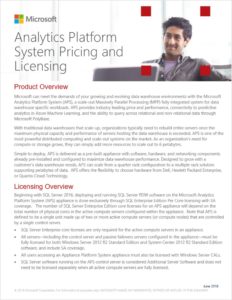
There’s a new (June 2016) Analytics Platform System Pricing and Licensing datasheet. What’s that in normal English? Well, this is the Massively Parallel Processing (MPP) appliance for data warehouse workloads which runs (keep with me here) SQL Server Parallel Data Warehouse edition. Bear in mind that when you acquire one of these appliances it’s pre-built, but you still need to purchase licences for the different components.
This datasheet does a good job of explaining the different servers and when Windows Server, System Center and SQL Enterprise licences are required.
Find it here: http://bit.ly/MSLicensingGuides.
